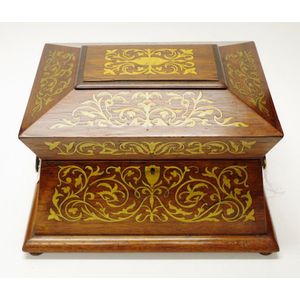Regency Brass Inlaid Jewellery Box with Lion Mask Handles
Large Regency brass inlaid jewellery box dual lion mask handles, lined interior with tray, circa 1830, 36 cm width; 24 cm deep; 24 cm high,.
You must be a subscriber, and be logged in to view price and dealer details.
Subscribe Now to view actual auction price for this item
When you subscribe, you have the option of setting the currency in which to display prices to $Au, $US, $NZ or Stg.
This item has been sold, and the description, image and price are for reference purposes only.
- Circa - A Latin term meaning 'about', often used in the antique trade to give an approximate date for the piece, usually considered to be five years on either side of the circa year. Thus, circa 1900 means the piece was made about 1900, probably between 1895 and 1905. The expression is sometimes abbreviated to c.1900.
- Regency Period - The Regency period in English furniture design refers to the period when King George III, was declared unfit to rule in 1811, and his son ruled as proxy as Prince Regent, until 1820, and then, after the death of his father as George IV until his death in 1830. The Regency period was preceded by the Georgian period (George I, George II, and George III: 1714 - 1811), and was followed by the William IV period, which only lasted until 1837 when William IV died as was succeeded by Queen Victoria.
- Lion Mask - The lion mask has been used for centuries in various forms of art and design, including furniture, silver, and ceramics, and is usually y depicted as a stylized representation of the face of a lion, often with an open mouth and protruding tongue. and is often used as a handle, knob, or other decorative element.
In furniture design, lion masks were popular in the neoclassical and Empire styles of the late 18th and early 19th centuries. They were often used as decorative elements on the legs or arms of chairs, as well as on cabinet and drawer pulls. It was also used as a handle, knob, or other decorative element.
In silverware design, lion masks were often applied to tea and coffee pots, as well as on candlesticks, snuff boxes, and other small silver items. The lion mask was often used in combination with other neoclassical motifs, such as laurel wreaths or acanthus leaves, to create a sense of grandeur and classical elegance.
In ceramics, lion masks were often depicted in relief, and were sometimes used in combination with other decorative elements, such as garlands or swags.
This item has been included into following indexes:
